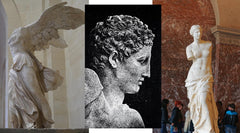Aesthetic Principles from Ancient Greece are still influential today
I recently had a conversation with a customer about the aesthetic principles from ancient Greece that got me thinking more about ancient Greek aesthetics and their influence on our current world.
Really - by what are we still influenced?
In fact, even after thousands of years, the ancient Greek principles of aesthetics can be found everywhere.
We are talking about harmony and symmetry, balance and proportions, about contrast and variety, about rhythms. Let us take a closer look at some of these principles that can be found in the various periods of Greek art.
Symmetry
First, the concept of symmetry. This can be seen in nature as well as in the arts.
In Ancient Greece, the term brought together different ideas: Evenness and harmony, something with correct proportions and therefore beauty. It is therefore a combination of philosophical and mathematical concepts.
The Pythagoreans had emphasized the importance of various opposites such as right and left, image and mirror image. Democritus had explained the composition of the world from atoms as building blocks, which possessed different geometrical forms, and Plato thought, the ground elements earth, water, air and fire would be based each on a corresponding geometrical form, e.g. the earth represented by a cube.
In other words: from the very beginning various sciences were concerned with symmetry, particularly philosophy, natural sciences and mathematics and this shaped the Aesthetic principles from Ancient Greece.
Balance
When we talk about ancient Greek architecture, we mean temple architecture, which was based on measure and proportion and the balance of all elements. The most well- known example is the Parthenon, built on the Acropolis of Athens in the fifth century BC, which was celebrated by its architects Ictinus and Callicrates as a triumph of balance.
Its decorative sculptures were created in strict accordance with rules laid down by the great sculptor Polyclitus, who wrote a treatise on the subject of proportions and balance in sculpture, the canon.
Also the „Golden Ratio“ (golden section) is an important principle of balance. The first preserved description is found in the „Elements“ of ancient Greek mathematician Euclid (around 300 BC). This ratio was later elevated to the ideal principle of aesthetic proportioning.
The relationship of the golden section, important in mathematics, art or architecture, can also be found in nature, for example in the arrangement of leaves.
Proportion
Proportion, too, is first a mathematical concept: the comparative relationship between parts of a whole. In art, it is described as how well balanced one part of an image is in relation to another. The same in architecture, proportion describes the way that different elements are related to each other in terms of size, shape and color. In a similar way, in music it refers to the way that rhythms relate to each other in time.
This concept, too, was first studied by ancient Greek philosophers and scientists like Plato and Pythagoras. Renewal of this belief in proportions as foundations of fine art took place later in the Renaissance.
Harmony
The term "harmony" comes from the Greek "harmonia," meaning "joint, agreement, concord of sounds.“ Ancient Greeks used it to describe architectural proportion, balance and the beauty of music. Harmony is a balance among elements and their relationships. A disharmonious composition lacks balance, and is therefore displeasing to the eye or ear. The ancient Greek philosophers Pythagoras and Plato showed how sound corresponded with numbers, and how these could be used to create pleasing music.
Rhythm
The ancient Greeks used „rhythm“ ( Greek: flow) in architecture and arts. Rhythm is a pattern created by repeating elements throughout the design, such as columns or arches. Rhythm was considered to be one of the key ingredients for the creation of harmony. It is the connection of elements in a whole, that is, the arrangement of parts to form a coherent whole.
Contrast and variety as an aesthetic principle
Also contrast and variety was used widely in ancient Greek architecture and arts. The columns of the Parthenon, for instance, were not all alike. The Doric order was used for the lower part of the building and Ionic for the upper part. One type was fluted and another was not. And each had a different capital or decoration at the top of the column.
Contrast in art was also used by making different parts of a statue from different materials - rock crystal for the eyes, ivory for the skin, and gold for hair. The same principle occurs in the color of ancient Greek statues.
The aesthetic lessons which can be learned from ancient Greek principles
This small selection shows how much aesthetic principles, integral to the artist's toolbox today, can be traced back to Ancient Greeks.
From typical Greek souvenirs to masterpieces of contemporary artists, designers and architects, these principles are still there to be found.
However, this also means that you, if you’re looking for some inspiration for your everyday life (home decor as an example), can discover plenty of ideas in Ancient Greece.
Takeaway: Aesthetic principles from ancient Greece are still influential today. Applying some of these principles will help you achieve the same kind of beauty in your immediate environment.
So get inspired by famous Greek art and sculptures or accessories inspired by Greek art.



















